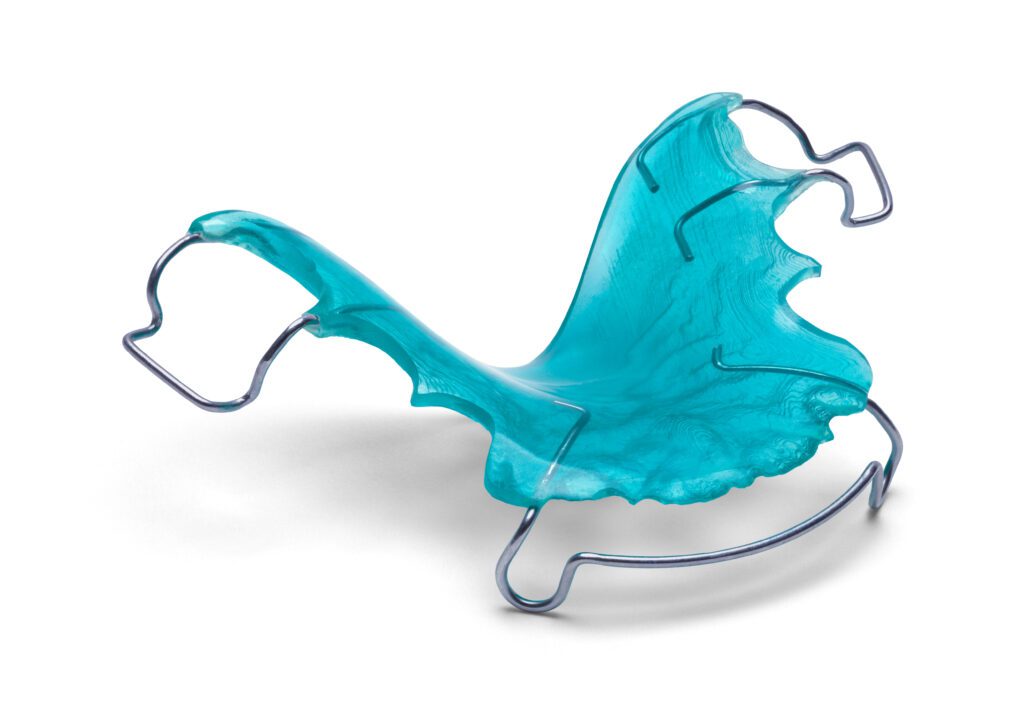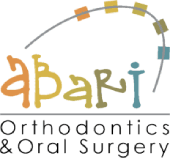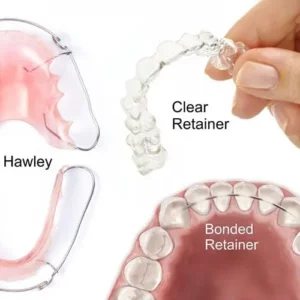
Retainers may be removable or fixed. They hold your teeth in their new, correct positions after your teeth have been straightened. Your orthodontist will instruct you on how to care for your retainer and about the duration of the wear. Wearing your retainer as directed is crucial to prevent the regression of your treatment.
Why Retainers?
The day the braces come off is an amazing day for any orthodontic patient, but don’t get ahead of yourself, because now that you have the smile you’ve always wanted, you have to keep it. That means wearing your retainers as instructed by Dr. Abari. The reason we need retainers in order to keep our teeth in their post-braces position is that it takes time for our teeth, gums, and jaw bones to get used to this new arrangement. So don’t slack off on wearing your retainers!
Retainer Instructions
YOU’VE WORKED HARD FOR YOUR BEAUTIFUL SMILE; KEEP IT THAT WAY!
Finally, your braces have been removed and your smile is beautiful, straight, and best of all, metal-free! However, your orthodontic journey isn’t quite completed. To keep your smile looking its best, you’ll have to wear a retainer to preserve and stabilize your results. Retainers are needed to control or limit potential changes in tooth position. They are used after braces treatment to hold teeth in their correct alignment while the surrounding gums, bone, and muscle adjust to the new positioning of your teeth.
TYPES OF RETAINERS
Retainers are custom-made and can be removable or fixed.
- Traditional removable retainers typically include a metal wire that surrounds the front teeth and is attached to an acrylic arch behind the teeth. The metal wires can be adjusted to finish treatment and continue minor movement of the front teeth as needed.
- Aligner-style retainers, or Essix retainers, look similar to clear aligners and offer a more aesthetic alternative to wire retainers. This clear retainer may fit over the entire arch of your teeth, or only from canine to canine (clip-on retainer). It is produced from a mold of your newly aligned teeth.
- Fixed retainers consist of a wire bonded behind the bottom and/or top teeth. While the device is usually required no more than a year after wisdom teeth have been extracted, it is often kept in place for life.
PROS AND CONS
- Removable retainers can be taken out for eating and hygiene routines.
- Removable retainers can get lost easily, so remember to keep yours in the case whenever you remove it to eat or brush.
- A fixed retainer is great if you don’t want to keep track of it, or if you don’t want to worry about how many hours per day it must be worn.
- Teeth with fixed retainers require a little extra attention to remove tartar while flossing. Patients with fixed retainers often must use floss threaders to pass dental floss through the small spaces between the retainer and the teeth.
How to Clean Retainers
To clean your retainer, use a toothbrush and water and simply brush the retainers as you would brush your own teeth. This will be the most effective way to keep your retainers clean. You may soak the retainers in a non-alcohol-based mouthwash for about an hour a day to give it a fresh, clean taste. You can also soak your retainers in a denture cleaner, such as Efferdent or Retainer Brite, which are often available over-the-counter at local drug stores and pharmacies. Never boil your retainer. It is not heat-resistant and will melt if you try to boil it.
Do I Need to Wear my Retainers for the Rest of My Life?
Yes, you do. But it won’t be as bad as you think, I promise (keep reading to find out why).
What is important is that you understand when to wear your retainer and when it’s okay not to wear your retainer. Here is how it works – when you get your braces off, your teeth will immediately want to go back to their original positions.
The bone surrounding your teeth is essentially what is holding them in place. That bone is soft at the end of treatment because it has been remodeled many times to allow your teeth to move to their new positions. Much like wet cement, your bone just needs time to harden around the teeth. Obviously, there are many other biological processes going on that make the process much more complicated than cement drying, but the idea is very much the same.
For that reason, you MUST WEAR YOUR RETAINERS FULL TIME for the first several years after your braces are removed. And by “Full Time” I mean a minimum of 22-23 hours per day. The only time you should be removing your retainers is to eat/drink and to brush your teeth. That’s it.
Over time, we will gradually decrease the amount of time you’ll need to wear your retainers. After several years, it should be okay for you to wear your retainers only several nights a week. I wish I could tell you that your teeth will stay put without needing retainers, but I would just be leading you down a road of frustration and disappointment. If you currently have a retainer, then you will likely fall into one of the categories listed below. It is important for you to know what you should do when you fall into one of the following categories:
- Retainers fitting well and not tight – You should continue to wear your retainer 2 to 4 nights per week.
- Retainers fitting okay (i.e. they can be fully seated on your teeth), but they are very tight– You must increase the use of your retainers to every night or even every day for a period of several years. The retainer can be used to actively “push” your teeth back to their original positions, but only if you are able to fully seat the retainer in your mouth. Once the retainer does not feel tight anymore, then you can decrease the use to 2 to 4 nights per week.
- Retainers do not fit at all– If you cannot fully seat your retainers, then you should call your orthodontist immediately. Your teeth have shifted BEYOND the point of using your old retainers to push them back into place. When you meet with your orthodontist, you will have three main options:
1. Do nothing. Even though this is an option, the main risk is that your teeth will continue to shift over time.
2. Make a new retainer. Making a new retainer will hold the CURRENT position of your teeth. It will NOT push your teeth back to where they were at the end of your orthodontic treatment (that’s what your old retainer could have done if you were able to fully seat it), but it WILL prevent your teeth from continuing to shift into worse positions.
3. Get treatment to correct the shifted teeth. This will likely be in the form of braces or clear aligners. If it’s just one tooth out of alignment, there may even be some limited treatment options with shorter treatment times. If you fall into one of the above categories, or you have specific questions regarding retainer care and maintenance, feel free to call our office at any time.
How Long do Removable Retainers Last?
On average, removable retainers should last several years. If you properly care for your retainers, many times your retainers will last much longer than expected. When your retainers begin to wear down or break, then you should call our office IMMEDIATELY to get a new set of retainers made. Do not put this off. If you do, then your teeth may shift and you may need treatment all over again.
What Happens if I Lose or Break My Retainers? Is it a Big Deal?
Yes, it is a big deal and here is why – your teeth will shift. I wish I could tell you otherwise, I really do. But the simple truth is that your teeth will move over time. That being said, when your retainer breaks, or if you lose your retainer, the best thing you can do for yourself is to call us immediately. If you get a new retainer shortly after breaking or losing it, then you will have nothing to worry about, and your teeth will remain in their current position (hopefully the same position as when you completed orthodontic treatment). However, if you do not act quickly to address the broken or loose retainer, then you run the risk of your teeth shifting.
If you lost or broke your retainer a long time ago, there is still hope. You should call your orthodontist to find out what your options are. The orthodontist should not make you feel bad about it. Instead, he or she will evaluate your teeth and talk with you about your options. Here are the three situations you may be in when you lose or break your retainer:
1. I broke/lost/stopped wearing my retainer a long time ago. What are my options?
Your orthodontist will first evaluate if your teeth have shifted. This could be in the form of crowding, spacing, rotations, overlaps, or maybe your bite just feels “off.” Since it has been a long time since you have worn your retainer, the chances are high that there has been some form of relapse. If this is the case, your options will be to
- Have limited orthodontic treatment to fix your teeth,
- Create a new retainer (or repair the old one) to hold the current position of your teeth, or
- Do nothing, with the risk of continued shifting of your teeth.
Regardless of what you decide, it is best to contact your orthodontist as soon as possible to discuss your options.
2. I broke/lost/stopped wearing my retainer recently. My teeth still look fine. Do I really need to come in?
That’s great that your teeth still look straight! However, don’t plan on it for too long because your teeth will move over time. If you want to keep your teeth in their current positions, the easiest and least expensive option is to simply call an orthodontist to have a new retainer made (or your broken retainer repaired). Taking care of it now will save you the trouble of needing treatment later on.
3. My lower bonded (metal) retainer (bar) is broken/loose on the inside of my bottom teeth. Can I just take it out?
You bet you can take it out! However, you will need to wear a new clear retainer that is intimately fitted to your teeth in order to prevent your lower teeth from shifting. Some people want to remove their metal bar to replace it with a removable retainer, whereas others simply want to get the metal bar re-cemented to their teeth. Regardless, it is important that you do something about your broken retainer to make sure your teeth do not continue to move over time.


